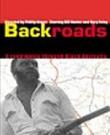AustLit
The material on this page is available to AustLit subscribers. If you are a subscriber or are from a subscribing organisation, please log in to gain full access. To explore options for subscribing to this unique teaching, research, and publishing resource for Australian culture and storytelling, please contact us or find out more.
Latest Issues
AbstractHistoryArchive Description
A vivid journey into the remote corners of white responsibility for black despair in Australia, Backroads was the first feature film to which Aboriginal people made a major creative contribution.
'Backroads tells the story of an aimless white drifter Bill who has a chance encounter with Aboriginal man Gary. They steal a car and petrol and supplies as they need it.'
'As they travel they pick up another Aboriginal man on the run from an unsuccessful marriage and the bored white wife of a service station owner. A French backpacker joins them for a short while.'
'Always on the run from police, boredom and guns turn into a deadly combination.' (Source: Shareourpride website)
Notes
-
While not a conventional crime film, Backroads does deal with crime and its ramifications, including the differing expectations of the legal system for white and Indigenous Australians.
Publication Details of Only Known VersionEarliest 2 Known Versions of
Works about this Work
-
Phillip Noyce : Man of Action
2017
single work
column
— Appears in: FilmInk , 28 November 2017; -
Black Power, Black Theatre and Black Humour
2012
single work
column
— Appears in: Tracker , September vol. 2 no. 17 2012; (p. 22) -
Dual Occupancy : Melbourne and the Feminist Drama of Dwelling in Monkey Grip
2012
single work
criticism
— Appears in: Studies in Australasian Cinema , March vol. 5 no. 3 2012; (p. 333-342) 'Monkey Grip is viewed as a film that evokes the sexual politics of feminism and of city life, and can thus be seen as both a feminist film and a 'Melbourne film', a convergence that emerges in other films made and set in Melbourne, including Love and Other Catastrophes. The city appears as a centre of dwelling and habitation, with attention drawn to the spectacle of the interiors of the residences, in which much of the action occurs, and with reflection on the conditions and values of production. Bachelard's notion of the house image is applied to distinguish the performances of gender from those in films in non-urban settings.' (Editor's abstract)
-
The Spirit of a Hunter, the Heart of a Blackfella
2011
single work
column
— Appears in: Tracker , June vol. 1 no. 3 2011; (p. 33) In his column The Contrarian, Gary Foley pays hommage to the late actor Bill Hunter and their roles together in Backroads. -
Saturday Reflection
2011
single work
column
— Appears in: The Saturday Age , 28 May 2011; (p. 23)
-
From Aboriginal Australia to German Autumn : On the West German Reception of Thirteen ‘Films from Black Australia’
2009
single work
criticism
— Appears in: Studies in Australasian Cinema , vol. 3 no. 3 2009; (p. 251-263) 'This article examines some aspects of the West German reception of a series of Australian films about Aborigines - including Peter Weir's The Last Wave (1977), Phillip Noyce's Backroads (1977) and Michael Edols' Lalai and Floating (1973 and 1975) - which were shown in Germany and elsewhere in Europe in 1978 and 1979. It explains how these films came to be shown in Europe, how and why they caught the imagination of German reviewers and film-makers at the time, and how they themselves contributed to the begetting of several German films on Aboriginal themes - including Nina Gladitz's documentary Das Uran gehört der Regenbogenschlange (The Uranium Belongs to the Rainbow Serpent) (1979), Werner Herzog's Where the Green Ants Dream (1984) and Wim Wenders' Until the End of the World (1991).' (Author's abstract) -
'Superboong!...' : The Ambivalence of Comedy and Differing Histories of Race
1996
single work
criticism
— Appears in: Continuum : Journal of Media & Cultural Studies , vol. 10 no. 2 1996; (p. 44-57) -
Saturday Reflection
2011
single work
column
— Appears in: The Saturday Age , 28 May 2011; (p. 23) -
The Spirit of a Hunter, the Heart of a Blackfella
2011
single work
column
— Appears in: Tracker , June vol. 1 no. 3 2011; (p. 33) In his column The Contrarian, Gary Foley pays hommage to the late actor Bill Hunter and their roles together in Backroads. -
Phillip Noyce
2006
single work
biography
— Appears in: Senses of Cinema , January - March no. 38 2006;
Settings:
- New South Wales,
Export this record




